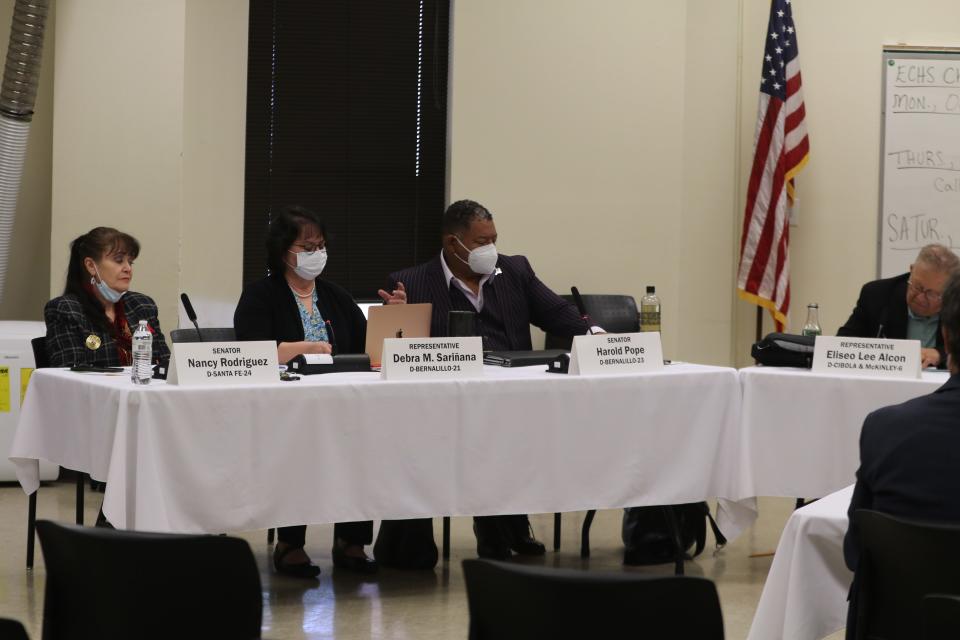New Mexico researchers report contamination, nuclear material in oil and gas wastewater
About 84 billion gallons of water was brought to the surface with the oil and gas extracted in New Mexico last year.
Known as “produced water” the byproduct of fossil fuel extraction comes from the same underground rock formations, or shale, where crude oil and gas natural gas is pumped from.
It’s high in toxic chemicals, heavy metals and brine and unfit for human consumption.
More: Rulemaking to ban 'forever chemicals' in New Mexico oil and gas debated by lawmakers
Traditionally, the fluid is disposed of via injection wells, pumping it back into the shale it came from.
But to address water scarcity and limit strain on freshwater sources, oil companies recently began recycling and reusing produced water in subsequent drilling activities.
The State of New Mexico was also pursuing research on how the substance could be treated and reused outside of the oil and gas industry, in industries like agriculture or municipal operations.
More: New Mexico could try again to challenge nuclear waste storage project in court
During a Tuesday meeting of the New Mexico Legislature’s Radioactive and Hazardous Materials Committee Dylan Fuge, director of the Oil Conservation Division told lawmakers the recent research generated better data as to how much produced water is generated and how it is used.
He said as oil and gas production continued to grow in New Mexico, there was likely to be even more produced water available to the state.
“We got better data on how much is generated each year,” Fuge said during the meeting at Southeast New Mexico College in Carlsbad. “Because produced water is a byproduct, it tracks pretty well with oil and gas that is produced.”
More: Only half of New Mexico's oil and gas operators are following state air pollution rules

He said in 2022, about 66 percent of water used by the oil and gas industry came from recycled produced water, and that a typical hydraulic fracturing operation used about 275,000 barrels – about 42 gallons each.
But disposal injections were still needed amid higher rates of fossil fuel production, Fuge said, and more water could strain disposal capacity and threaten higher seismicity particularly in the southeast Permian Basin region.
As oil and gas boomed and created a higher volume of water disposed, the region along with areas of West Texas also within the Permian saw a rapid increase in earthquakes believed tied to the injection wells.
More: Can smaller tremors protect New Mexico from oil and gas earthquakes in Permian Basin?
This led to the OCD enacting restrictions on injection volumes, potentially curbing injection volumes or shutting in disposal wells completely, based on their proximity to reported earthquakes and the magnitude of the events.
“While we’ve made significant progress in reducing the volumes of freshwater that goes to oil and gas, recent increases in production have presented challenges,” Fuge said.
He said the Oil Conservation Commission, the OCD’s governing body, was considering a pilot project for shallow disposal wells, which could avoid stimulating deep faults and basement rocks typically known to cause seismic events.
More: Permian Basin oil production dips although projections show growth in coming years
“One of the challenges with managing produced water is where to put it, so shallow disposal wells is one of those avenues,” Fuge said.
State hopes oil and gas wastewater could alleviate drought
A package of bills could also be introduced during the upcoming Legislative Session starting in January 2024, Fuge said, to better regulate freshwater use, well placement and other rules relate to oil and gas and its impact on the environment.
But present work revolved around the Produced Water Act passed in 2019 that clarified the OCD’s authority to manage produced water within the oil and gas industry, and tasked the New Mexico Environment Department (NMED) with regulating potential uses in other industries.
More: Exxon Mobil in talks to buy Pioneer Natural Resources in $60B Permian Basin merger

John Rhoderick, director of NMED’s Water Protection Division said during the meeting that produced water could be used as an alternative to some of New Mexico’s freshwater sources throughout the arid state.
New Mexico continued to struggle with a multi-year drought, with the U.S. Drought Monitor reporting Oct. 5 about 99 percent of the state saw some drought conditions, while about 68 percent was in “extreme drought."
Although produced water could increase water availability, it will not completely take the strain off of New Mexico’s surface water, Rhoderick said.
“Produced water is one of the sources we’re looking at as far as an alternate water supply,” he said. “It will reduce the need and use of surface water, but it will not replace it.”
More: New Mexicans call for end of oil and gas during United Nations climate summit
To that end, NMED along with New Mexico State University formed the state’s Produced Water Research Consortium, which was underway with characterizing what exactly is in produced in hopes of developing methods for treatment.
“We’re a long way from where we would even consider discharging this water into the ground,” Rhoderick said. “We really see more industrial applications for it than drinking water, but if the industrial applications can reduce the pressure on freshwater sources and drinking water, then we’ve accomplished the task.”
Consortium Research Director Pei Xu said to lawmakers that researchers found suspended solids like oil and grease in the produced water they studied, along with salts, microorganisms and natural occurring radioactive material (NORM).
More: How 'green' is New Mexico really? Do recent oil and gas reforms go far enough?

She said the quality of produced water varies greatly based on location and the depth of the well.
“The produced water chemistry is very complex,” Xu said. “We are interested in all these compounds. The produced water quality is highly variable.”
Some of these contaminants were also found in water samples taken from the Pecos River, Xu said, which runs through the southeast corner where New Mexico’s fossil fuel operations are concentrated.
Those contaminants were a concern for Vice Chair Sen. Jeff Steinborn (D-36) who said the State needed to place heavier restrictions on oil and gas companies producing the byproduct fluids.
“I find it troubling that we’re spending so much money to figure this out to protect human health, and yet we’re allowing New Mexico’s public lands to be leased and create these contaminants that are found in our river,” Steinborn said. “And we’re still protecting the polluter.”
More: Oil drilling could be blocked from southeast New Mexico cave system. Here's how to object.
Sen. Harold Pope (D-23) urged caution in reintroducing produced water into New Mexico’s freshwater supplies.
“My concern is we’re treating the brackish water the same as the produced water, and that we’re treating it and making sure it’s safe before we introduce it into our water,” he said. “I understand that we’re not perfect and we’re not going to find everything. We just need to be careful with what we’re introducing into our clean water.”
Adrian Hedden can be reached at 575-628-5516, achedden@currentargus.com or @AdrianHedden on X, formerly known as Twitter.
This article originally appeared on Carlsbad Current-Argus: New Mexico researchers report contamination in oil and gas wastewater

